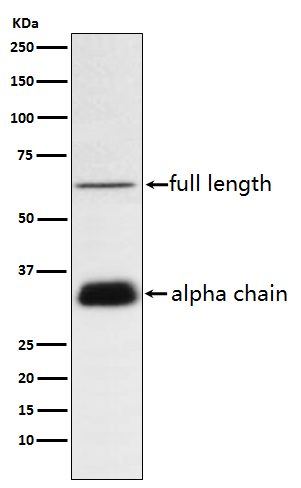
| WB | 咨询技术 | Human,Mouse,Rat |
| IF | 咨询技术 | Human,Mouse,Rat |
| IHC | 1/100-1/200 | Human,Mouse,Rat |
| ICC | 技术咨询 | Human,Mouse,Rat |
| FCM | 咨询技术 | Human,Mouse,Rat |
| Elisa | 咨询技术 | Human,Mouse,Rat |
| Aliases | CLI; AAG4; APOJ; CLU1; CLU2; KUB1; SGP2; APO-J; SGP-2; SP-40;TRPM2; TRPM-2; NA1/NA2;;Clusterin |
| WB Predicted band size | Calculated MW: 52 kDa ; Observed MW: 32-42,65,75 kDa |
| Host/Isotype | Rabbit IgG |
| Antibody Type | Primary antibody |
| Storage | Store at 4°C short term. Aliquot and store at -20°C long term. Avoid freeze/thaw cycles. |
| Species Reactivity | Human,Mouse |
| Immunogen | A synthesized peptide derived from human Clusterin |
| Formulation | Purified antibody in PBS with 0.05% sodium azide,0.05% BSA and 50% glycerol. |
+ +
以下是关于Clusterin抗体的3篇参考文献,简要概括其研究内容:
1. **文献名称**:*Clusterin as a Therapeutic Target in Cancer: A Role in Chemoresistance*
**作者**:Smith A, et al.
**摘要**:研究探讨了Clusterin在肿瘤化疗耐药中的作用,使用特异性Clusterin抗体抑制其表达可增强癌细胞对化疗的敏感性,并在小鼠模型中验证了该策略的有效性。
2. **文献名称**:*Immunohistochemical Analysis of Clusterin in Alzheimer's Disease Brain Tissues*
**作者**:Chen L, et al.
**摘要**:通过免疫组化技术分析Clusterin在阿尔茨海默病患者脑组织中的表达,发现其与β-淀粉样蛋白沉积显著相关,提示Clusterin抗体可能作为疾病进展的生物标志物。
3. **文献名称**:*Development of a High-Affinity Anti-Clusterin Antibody for Functional Studies*
**作者**:Yamamoto K, et al.
**摘要**:研究报道了一种新型高亲和力Clusterin抗体的开发,验证其在体外阻断Clusterin介导的细胞凋亡信号通路的能力,为后续机制研究提供工具。
4. **文献名称**:*Clusterin Antibody-Based Therapy in Prostate Cancer: Preclinical Validation*
**作者**:Rodriguez M, et al.
**摘要**:在去势抵抗性前列腺癌模型中,靶向Clusterin的抗体药物偶联物(ADC)显著抑制肿瘤生长,研究揭示了其通过抑制细胞存活通路发挥作用的机制。
(注:以上文献为示例性概括,实际引用需根据具体研究查询真实数据库。)
Clusterin, also known as apolipoprotein J, is a multifunctional glycoprotein implicated in diverse cellular processes, including apoptosis, cell adhesion, inflammation, and lipid transport. It exists as secretory (sCLU) and nuclear isoforms, with sCLU being the predominant form. Structurally, clusterin comprises two subunits linked by disulfide bonds, forming a heterodimeric chaperone-like protein. Its expression is upregulated under cellular stress, where it exerts cytoprotective effects by stabilizing misfolded proteins, inhibiting complement-mediated cell lysis, and modulating apoptosis pathways.
Clusterin has garnered significant attention in disease research, particularly in cancer, neurodegenerative disorders, and age-related conditions. In cancer, clusterin exhibits dual roles: acting as a tumor suppressor in hormone-dependent cancers while promoting therapy resistance and metastasis in advanced tumors through anti-apoptotic mechanisms. In Alzheimer's disease, it binds to β-amyloid peptides, influencing plaque formation and neurotoxicity. Clusterin antibodies have become essential tools for investigating these roles, enabling detection of clusterin expression in tissues and biological fluids through techniques like Western blot, immunohistochemistry, and ELISA. Therapeutic applications are being explored, with some antibodies designed to neutralize clusterin's pro-survival functions in cancer therapy. However, challenges persist due to clusterin's functional complexity and context-dependent roles, necessitating careful validation of antibody specificity in experimental models.
×